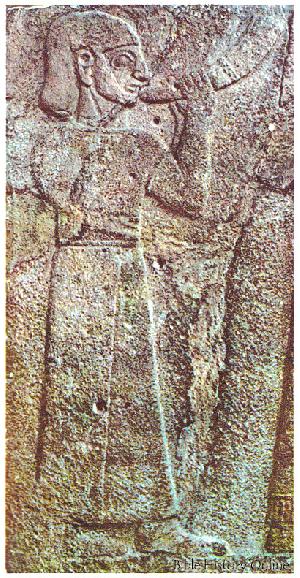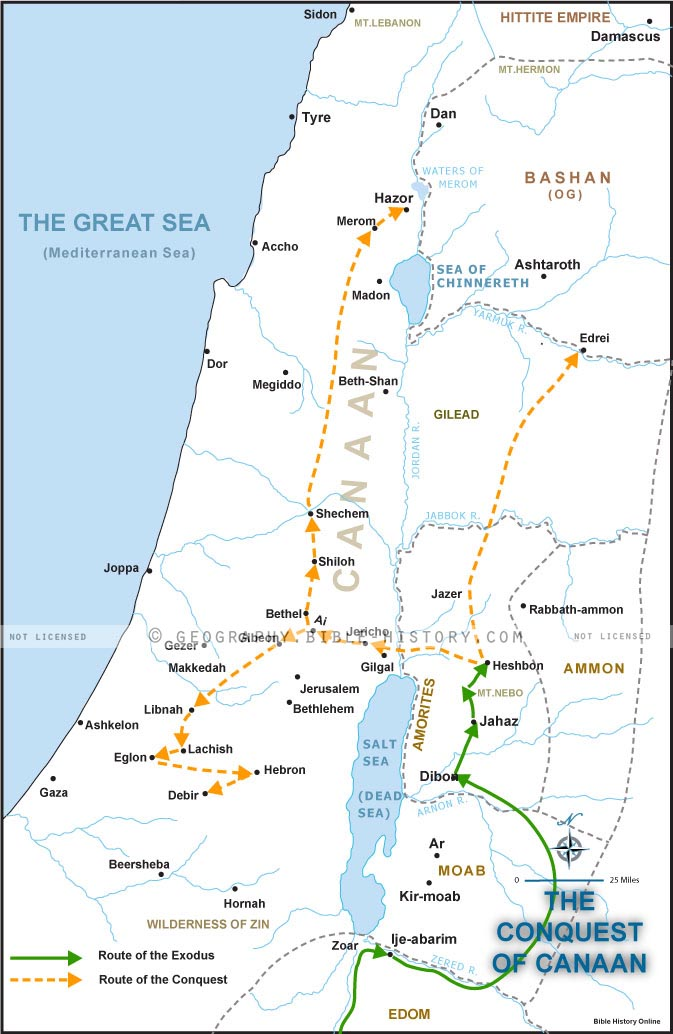Joshua
Images and Notes
The Book of Joshua
Joshua 5:13 - And it came to pass, when Joshua was by
Jericho, that he lifted up his eyes and looked, and, behold,
there stood a man over against him with his sword drawn in his
hand: and Joshua went unto him, and said unto him, [Art] thou
for us, or for our adversaries?
Joshua
5:14 - And he said, Nay; but [as] captain of the host of the
LORD am I now come. And Joshua fell on his face to the earth,
and did worship, and said unto him, What saith my lord unto his
servant?
Joshua
5:15 - And the captain of the LORD'S host said unto Joshua,
Loose thy shoe from off thy foot; for the place whereon thou
standest [is] holy. And Joshua did so.
The Old Testament - A Brief Overview
Bible Survery - Joshua
Hebrew Name - Yehoshua "Yahweh is salvation"
Greek Name - Iesous (Greek form of the Hebrew)
Author - Joshua
Date - From 1451 to 1425 BC Approximately
Theme - The Conquest of Canaan
Types and Shadows - In Joshua Jesus is the captain of the LORD's
host
ARCHAEOLOGY
Ancient Rallying Horn

This Carchemish relief reveals how horns were blown.
Summary of The Book of Joshua
The book of Joshua received its name because of the main
character of the book which is Joshua, whose name means "Jehovah
is salvation". The Greek form of the name of Joshua is actually
Jesus and means the same thing as the Hebrew Joshua. The
man Joshua makes his first appearance as the commander of the
armies of Israel against the Amalekites in the book of Exodus
(Exodus 17:8 ff). Joshua was clearly a leader of Israel, he
accompanied Moses to the foot of Mount Sinai when Moses went up
on the mountain to receive the 10 Commandments, but Joshua did
not go up with him (Exodus 24).
The way that Joshua enters the book of Joshua is
already as an established leader in. Even Moses commissioned
Joshua as the man chosen and conquer the land.
When Moses gave his farewell speech in Deuteronomy 34 Joshua
accompanied him to the foot of Mount Sinai
This book is named
for its chief character, Joshua, whose name means "Jehovah is salvation." The
Greek form of this name is Jesus. The first appearance of Joshua is as the
leader of the forces of Israel against Amalek (Exodus 17:8ff). The manner in which
he is introduced into the story indicates that he was already well established
as a leader. Later, he accompanied Moses to the foot of Mt. Sinai, but did not
make the ascent with him (Exodus 24). In Exodus 32-33 he is also found in close
association with Moses. No doubt, the years which he spent with Moses greatly
influenced his spiritual development. The aspect of his life for which Joshua is
most often remembered is his having brought back a positive report from the land
of Canaan after serving as one of twelve men sent to spy out the land (Numbers 13).
From this it can be seen that the experience and spirit which were Joshua's
equipped him well for his duties and responsibilities as the leader, of God's
people.
Quick Reference Map

Map of the Conquest of Canaan (Click to
Enlarge)
The book may be regarded as consisting of three parts which
may be analyzed as follows :
Outline of the Book of Joshua
1) The Conquest of Canaan (Joshua 1-12). This includes the preparation for and
crossing of the Jordan (Joshua 1-4). After the crossing, they camped at Gilgal. Here
they circumcised all the males who were born in the wilderness, as circumcision
had not been observed since the departure from Egypt. Gilgal was also the scene
of the keeping of the Passover and the cessation of the manna. Joshua 5:13-6:27 tells
of the miraculous destruction of Jericho and the salvation of Rahab. The crime
and punishment of Achan is discussed in Joshua 7. In Joshua 8, the narrative records
the avenging of the defeat which Israel had suffered at the hands of Al because
of the sin of Achan. The latter portion of this chapter tells of the setting up
of the stones on Mount Ebal. The stratagem of the Gibeonites is the topic of
Joshua
9. In Joshua 10 is contained the story of the conquest of Southern Canaan, with the
aid of Joshua's long day. Joshua 11-12 describes the conquest of Northern Canaan
and give a list of the defeated kings.
2) The Distribution of the Territory (Joshua 13-22). This provides a record of the
area which was assigned to the various tribes (13-19), the appointment of the
six cities of refuge (Joshua 20) and the forty-eight cities of the Levites (Joshua
21), as well as the departure of the Transjordanic tribes to their home.
3) Joshua's farewell addresses (Joshua 23-24). The first of these is a speech of
encouragement and warning. The second recalls the history of Israel, with
emphasis on divine interventions on their behalf. At the close of this speech,
Joshua issued the famous statement, "choose you this day whom you will serve . .
. but as for me and my house, we will serve the Lord" (Joshua 24:15).
The book closes with an account of the renewal of the
covenant and the death of Joshua and Eleazer.
Quick Reference Maps
The Conquest of Canaan
The City of Jericho
The City of Sidon
Philistia
The Twelve Tribes

Joshua Resources
Joshua and the Promised Land
More About the Book of Joshua
Joshua in the
Picture Study Bible
Timeline of the Ancient
World
Back to the Old
Testament
Back to Bible
History Online







